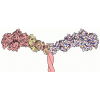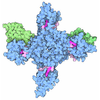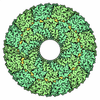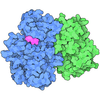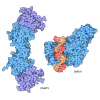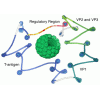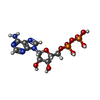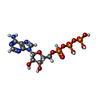[English] 日本語
 Yorodumi
Yorodumi- EMDB-37988: Structure of nucleosome-bound SRCAP-C in the ADP-BeFx-bound state -
+ Open data
Open data
- Basic information
Basic information
| Entry |  | |||||||||
|---|---|---|---|---|---|---|---|---|---|---|
| Title | Structure of nucleosome-bound SRCAP-C in the ADP-BeFx-bound state | |||||||||
 Map data Map data | Structure of nucleosome-bound SRCAP-C in the ADP-BeFx-bound state | |||||||||
 Sample Sample |
| |||||||||
 Keywords Keywords | Remodeler / SRCAP / H2A.Z / DNA BINDING PROTEIN/DNA / DNA BINDING PROTEIN-DNA complex | |||||||||
| Function / homology |  Function and homology information Function and homology informationpositive regulation of lymphoid progenitor cell differentiation / histone H3K18ac reader activity / histone H3K27ac reader activity / promoter-enhancer loop anchoring activity / intestinal stem cell homeostasis / positive regulation of norepinephrine uptake / telomerase RNA localization to Cajal body / regulation of DNA strand elongation / positive regulation of telomere maintenance in response to DNA damage / hematopoietic stem cell homeostasis ...positive regulation of lymphoid progenitor cell differentiation / histone H3K18ac reader activity / histone H3K27ac reader activity / promoter-enhancer loop anchoring activity / intestinal stem cell homeostasis / positive regulation of norepinephrine uptake / telomerase RNA localization to Cajal body / regulation of DNA strand elongation / positive regulation of telomere maintenance in response to DNA damage / hematopoietic stem cell homeostasis / histone chaperone activity / establishment of protein localization to chromatin / cellular response to cytochalasin B / bBAF complex / npBAF complex / R2TP complex / nBAF complex / brahma complex / heart process / regulation of transepithelial transport / dynein axonemal particle / neural retina development / morphogenesis of a polarized epithelium / structural constituent of postsynaptic actin cytoskeleton / GBAF complex / Formation of annular gap junctions / negative regulation of G0 to G1 transition / Formation of the dystrophin-glycoprotein complex (DGC) / protein localization to adherens junction / Gap junction degradation / regulation of G0 to G1 transition / Folding of actin by CCT/TriC / Swr1 complex / dense body / Cell-extracellular matrix interactions / postsynaptic actin cytoskeleton / Tat protein binding / RPAP3/R2TP/prefoldin-like complex / Activation of the TFAP2 (AP-2) family of transcription factors / Prefoldin mediated transfer of substrate to CCT/TriC / RSC-type complex / Ino80 complex / blastocyst formation / regulation of nucleotide-excision repair / muscle cell differentiation / regulation of double-strand break repair / adherens junction assembly / RHOF GTPase cycle / Adherens junctions interactions / nucleolus organization / apical protein localization / Sensory processing of sound by outer hair cells of the cochlea / tight junction / positive regulation of DNA damage response, signal transduction by p53 class mediator / box C/D snoRNP assembly / Interaction between L1 and Ankyrins / SWI/SNF complex / regulation of mitotic metaphase/anaphase transition / protein folding chaperone complex / Sensory processing of sound by inner hair cells of the cochlea / negative regulation of transcription by RNA polymerase I / positive regulation of T cell differentiation / regulation of norepinephrine uptake / apical junction complex / transporter regulator activity / positive regulation of double-strand break repair / spinal cord development / maintenance of blood-brain barrier / nitric-oxide synthase binding / establishment or maintenance of cell polarity / cortical cytoskeleton / NuA4 histone acetyltransferase complex / regulation of chromosome organization / positive regulation of stem cell population maintenance / RUNX1 interacts with co-factors whose precise effect on RUNX1 targets is not known / positive regulation of transcription by RNA polymerase I / Regulation of MITF-M-dependent genes involved in pigmentation / Recycling pathway of L1 / brush border / regulation of G1/S transition of mitotic cell cycle / TFIID-class transcription factor complex binding / regulation of DNA replication / regulation of T cell proliferation / MLL1 complex / kinesin binding / regulation of embryonic development / Telomere Extension By Telomerase / EPH-ephrin mediated repulsion of cells / negative regulation of cell differentiation / somatic stem cell population maintenance / regulation of synaptic vesicle endocytosis / RHO GTPases Activate WASPs and WAVEs / positive regulation of myoblast differentiation / positive regulation of transcription initiation by RNA polymerase II / RHO GTPases activate IQGAPs / regulation of protein localization to plasma membrane / positive regulation of double-strand break repair via homologous recombination / histone acetyltransferase activity / negative regulation of megakaryocyte differentiation / RNA polymerase II core promoter sequence-specific DNA binding Similarity search - Function | |||||||||
| Biological species |  Homo sapiens (human) Homo sapiens (human) | |||||||||
| Method | single particle reconstruction / cryo EM / Resolution: 3.2 Å | |||||||||
 Authors Authors | Yu J / Wang Q / Yu Z / Li W / Wang L / Xu Y | |||||||||
| Funding support |  China, 1 items China, 1 items
| |||||||||
 Citation Citation |  Journal: Cell Discov / Year: 2024 Journal: Cell Discov / Year: 2024Title: Structural insights into histone exchange by human SRCAP complex. Authors: Jiali Yu / Fengrui Sui / Feng Gu / Wanjun Li / Zishuo Yu / Qianmin Wang / Shuang He / Li Wang / Yanhui Xu /  Abstract: Histone variant H2A.Z is found at promoters and regulates transcription. The ATP-dependent chromatin remodeler SRCAP complex (SRCAP-C) promotes the replacement of canonical histone H2A-H2B dimer with ...Histone variant H2A.Z is found at promoters and regulates transcription. The ATP-dependent chromatin remodeler SRCAP complex (SRCAP-C) promotes the replacement of canonical histone H2A-H2B dimer with H2A.Z-H2B dimer. Here, we determined structures of human SRCAP-C bound to H2A-containing nucleosome at near-atomic resolution. The SRCAP subunit integrates a 6-subunit actin-related protein (ARP) module and an ATPase-containing motor module. The ATPase-associated ARP module encircles half of the nucleosome along the DNA and may restrain net DNA translocation, a unique feature of SRCAP-C. The motor module adopts distinct nucleosome binding modes in the apo (nucleotide-free), ADP-bound, and ADP-BeF-bound states, suggesting that ATPase-driven movement destabilizes H2A-H2B by unwrapping the entry DNA and pulls H2A-H2B out of nucleosome through the ZNHIT1 subunit. Structure-guided chromatin immunoprecipitation sequencing analysis confirmed the requirement of H2A-contacting ZNHIT1 in maintaining H2A.Z occupancy on the genome. Our study provides structural insights into the mechanism of H2A-H2A.Z exchange mediated by SRCAP-C. | |||||||||
| History |
|
- Structure visualization
Structure visualization
- Downloads & links
Downloads & links
-EMDB archive
| Map data |  emd_37988.map.gz emd_37988.map.gz | 227.8 MB |  EMDB map data format EMDB map data format | |
|---|---|---|---|---|
| Header (meta data) |  emd-37988-v30.xml emd-37988-v30.xml emd-37988.xml emd-37988.xml | 46.3 KB 46.3 KB | Display Display |  EMDB header EMDB header |
| Images |  emd_37988.png emd_37988.png | 94 KB | ||
| Filedesc metadata |  emd-37988.cif.gz emd-37988.cif.gz | 11.8 KB | ||
| Others |  emd_37988_additional_1.map.gz emd_37988_additional_1.map.gz emd_37988_additional_2.map.gz emd_37988_additional_2.map.gz emd_37988_additional_3.map.gz emd_37988_additional_3.map.gz emd_37988_additional_4.map.gz emd_37988_additional_4.map.gz emd_37988_half_map_1.map.gz emd_37988_half_map_1.map.gz emd_37988_half_map_2.map.gz emd_37988_half_map_2.map.gz | 20.3 MB 136.6 MB 138.1 MB 136.6 MB 193.4 MB 193.4 MB | ||
| Archive directory |  http://ftp.pdbj.org/pub/emdb/structures/EMD-37988 http://ftp.pdbj.org/pub/emdb/structures/EMD-37988 ftp://ftp.pdbj.org/pub/emdb/structures/EMD-37988 ftp://ftp.pdbj.org/pub/emdb/structures/EMD-37988 | HTTPS FTP |
-Validation report
| Summary document |  emd_37988_validation.pdf.gz emd_37988_validation.pdf.gz | 942.3 KB | Display |  EMDB validaton report EMDB validaton report |
|---|---|---|---|---|
| Full document |  emd_37988_full_validation.pdf.gz emd_37988_full_validation.pdf.gz | 941.9 KB | Display | |
| Data in XML |  emd_37988_validation.xml.gz emd_37988_validation.xml.gz | 15.6 KB | Display | |
| Data in CIF |  emd_37988_validation.cif.gz emd_37988_validation.cif.gz | 18.5 KB | Display | |
| Arichive directory |  https://ftp.pdbj.org/pub/emdb/validation_reports/EMD-37988 https://ftp.pdbj.org/pub/emdb/validation_reports/EMD-37988 ftp://ftp.pdbj.org/pub/emdb/validation_reports/EMD-37988 ftp://ftp.pdbj.org/pub/emdb/validation_reports/EMD-37988 | HTTPS FTP |
-Related structure data
| Related structure data |  8x19MC  8x15C  8x1cC M: atomic model generated by this map C: citing same article ( |
|---|---|
| Similar structure data | Similarity search - Function & homology  F&H Search F&H Search |
- Links
Links
| EMDB pages |  EMDB (EBI/PDBe) / EMDB (EBI/PDBe) /  EMDataResource EMDataResource |
|---|---|
| Related items in Molecule of the Month |
- Map
Map
| File |  Download / File: emd_37988.map.gz / Format: CCP4 / Size: 244.1 MB / Type: IMAGE STORED AS FLOATING POINT NUMBER (4 BYTES) Download / File: emd_37988.map.gz / Format: CCP4 / Size: 244.1 MB / Type: IMAGE STORED AS FLOATING POINT NUMBER (4 BYTES) | ||||||||||||||||||||
|---|---|---|---|---|---|---|---|---|---|---|---|---|---|---|---|---|---|---|---|---|---|
| Annotation | Structure of nucleosome-bound SRCAP-C in the ADP-BeFx-bound state | ||||||||||||||||||||
| Voxel size | X=Y=Z: 1.334 Å | ||||||||||||||||||||
| Density |
| ||||||||||||||||||||
| Symmetry | Space group: 1 | ||||||||||||||||||||
| Details | EMDB XML:
|
-Supplemental data
- Sample components
Sample components
+Entire : Structure of nucleosome-bound SRCAP-C in the ADP-BeFx-bound state
+Supramolecule #1: Structure of nucleosome-bound SRCAP-C in the ADP-BeFx-bound state
+Macromolecule #1: Histone H2A type 1-C
+Macromolecule #2: Histone H2B type 1-C/E/F/G/I
+Macromolecule #3: Histone H3.1
+Macromolecule #4: Histone H4
+Macromolecule #5: Helicase SRCAP
+Macromolecule #6: Vacuolar protein sorting-associated protein 72 homolog
+Macromolecule #7: Actin-related protein 6
+Macromolecule #8: Zinc finger HIT domain-containing protein 1
+Macromolecule #9: RuvB-like 1
+Macromolecule #10: RuvB-like 2
+Macromolecule #11: Actin, cytoplasmic 1
+Macromolecule #12: Actin-like protein 6A
+Macromolecule #13: DNA methyltransferase 1-associated protein 1
+Macromolecule #14: YEATS domain-containing protein 4
+Macromolecule #15: DNA (147-MER)
+Macromolecule #16: DNA (147-MER)
+Macromolecule #17: ADENOSINE-5'-DIPHOSPHATE
+Macromolecule #18: MAGNESIUM ION
+Macromolecule #19: BERYLLIUM TRIFLUORIDE ION
+Macromolecule #20: ADENOSINE-5'-TRIPHOSPHATE
-Experimental details
-Structure determination
| Method | cryo EM |
|---|---|
 Processing Processing | single particle reconstruction |
| Aggregation state | particle |
- Sample preparation
Sample preparation
| Buffer | pH: 8 |
|---|---|
| Vitrification | Cryogen name: ETHANE |
- Electron microscopy
Electron microscopy
| Microscope | FEI TITAN KRIOS |
|---|---|
| Image recording | Film or detector model: GATAN K3 (6k x 4k) / Average electron dose: 50.0 e/Å2 |
| Electron beam | Acceleration voltage: 300 kV / Electron source:  FIELD EMISSION GUN FIELD EMISSION GUN |
| Electron optics | Illumination mode: FLOOD BEAM / Imaging mode: BRIGHT FIELD / Nominal defocus max: 2.5 µm / Nominal defocus min: 1.5 µm |
| Experimental equipment |  Model: Titan Krios / Image courtesy: FEI Company |
- Image processing
Image processing
| Startup model | Type of model: PDB ENTRY PDB model - PDB ID: |
|---|---|
| Final reconstruction | Resolution.type: BY AUTHOR / Resolution: 3.2 Å / Resolution method: FSC 0.143 CUT-OFF / Number images used: 475617 |
| Initial angle assignment | Type: MAXIMUM LIKELIHOOD |
| Final angle assignment | Type: MAXIMUM LIKELIHOOD |
 Movie
Movie Controller
Controller











